Trees are an important part of the environment. From the moment they sprout, their roots grow deep into the ground, holding the soil in place. Throughout a tree’s lifetime, it provides oxygen, acts as a habitat for birds and animals, and gives shade on hot, sunny days. Many trees growing together become a forest, an important ecosystem filled with biodiversity.
So when a forest is completely cut down, people like Doug McCallum are stepping up to protect and plant as many trees as possible and to inspire others to do the same.
He started a group in his community to support the cause, and it all started when he noticed large sections of trees being cut down.

Newly planted trees beside a forest.
A Growing Problem
“I began this whole thing three years ago when the pandemic started. There was a lot of tree clear cutting happening in Kincardine and two of us started a Facebook group called Kincardinites Concerned for Our Trees,” he explains.
He started by approaching the town council to advocate for a by-law to be put in place to stop the clear cutting. Clear cutting is sometimes done to create room in a specific area for housing developments, farmland, or other types of developments.
“One of the councillors contacted me and said they couldn’t do much at the time to help stop the clear cutting, but they asked if we wanted to plant trees in a park that wasn’t being used anymore,” Doug says.
While he was hoping for a by-law to be put in place to stop the clear cutting, like many neighbouring communities have, he turned his attention to planting trees.
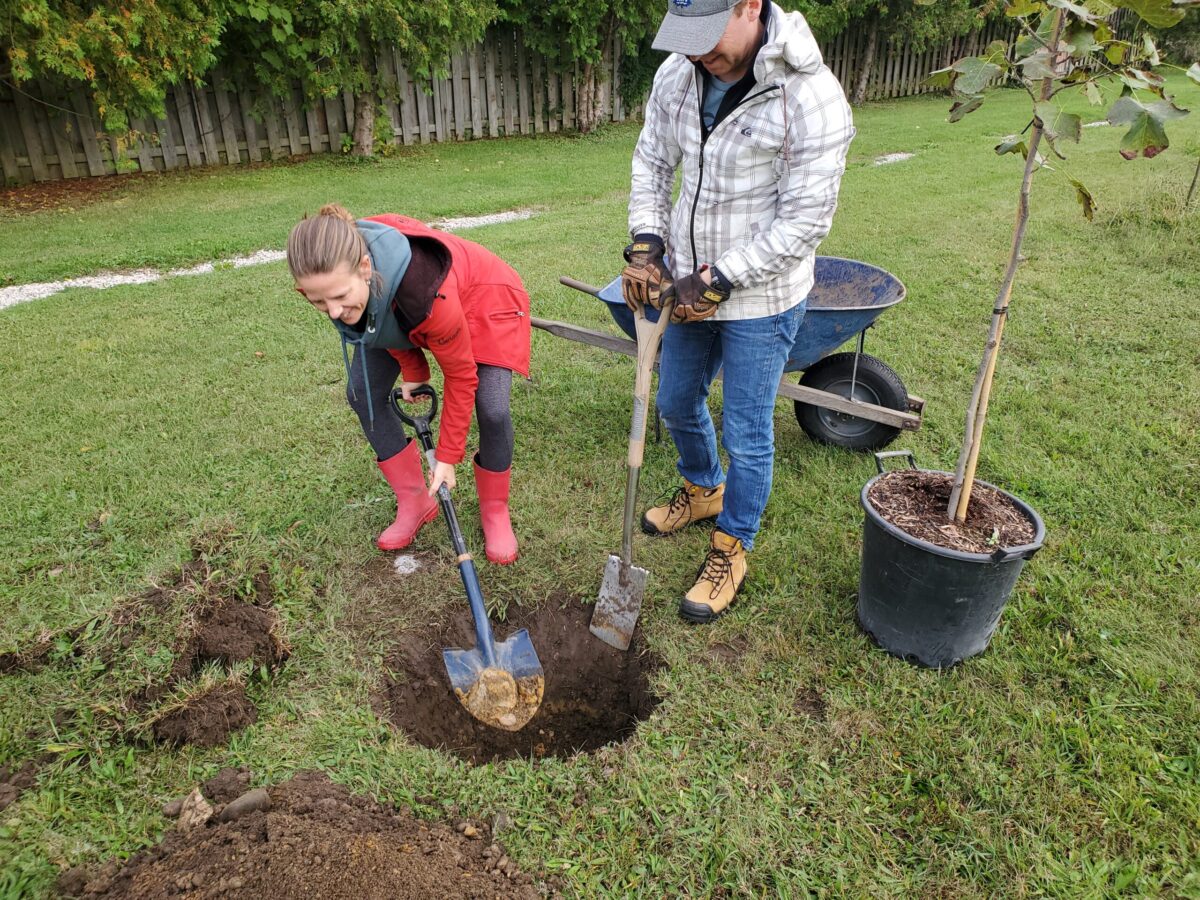
Volunteers digging a hole in a local park.
Starting Small
“That spring, I ordered one hundred tiny saplings from the Pine River Watershed Initiative and we planted them in Riggin Park in the north end of Kincardine. Last year, the Rotary Club donated 50 fairly large trees and we had a tree planting day with them,” he says.
The tree planting efforts didn’t stop there. Relying on donations, Doug was offered trees from homeowners who had plenty growing on their properties. As monetary donations started to flow in, he purchased more saplings to plant in Riggin Park.
“I was finding the tree plantings to be a lot to organize myself so I put out a call for volunteers on our Facebook group, asking if anybody would like to volunteer to help me to form a not-for-profit group whose only intent was to plant trees and wildflowers, to renaturalize places in Kincardine,” he says.
And that’s when Doug and a few others formed a not-for-profit group they called Kincardine Naturalization Projects.
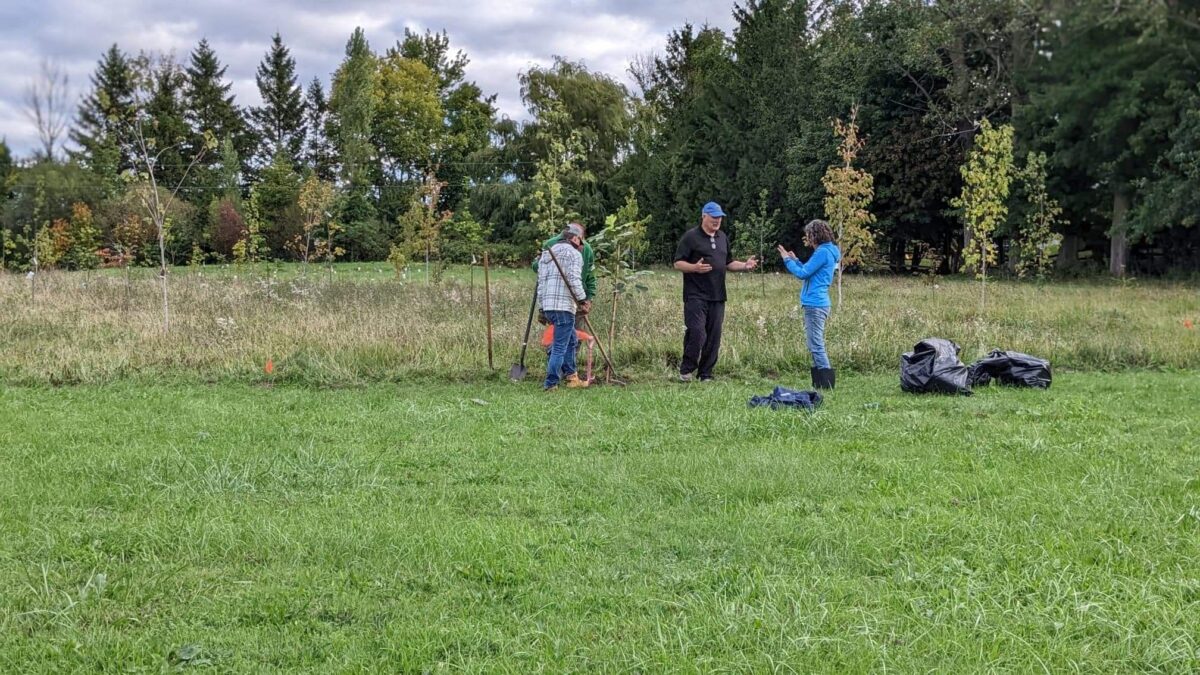
Volunteers with Kincardine Naturalization Projects.
Growing the Group
“When I asked for volunteers last year, I had two people help out. The three of us have helped get this group going by organizing tree plantings,” he says.
To raise money to buy trees and planting supplies, the group has held raffles with prizes donated by dozens of local businesses. Last year’s raffle raised about $2,000, which went towards naturalization projects and purchasing trees and birdhouses.
The trio work together on applying for grants and sponsorships, deciding which native trees to plant in which locations, and talking to ecologists and other environmental experts in the area.
They held a tree planting event last year and Doug says they were expecting 15 volunteers to show up.
“We ended up getting about 60 volunteers. It was overwhelming seeing how many people showed up. Everybody was happy and they were all there for the same reason: to put more trees back into our community. People are really excited about it. They really want to get involved,” he says.
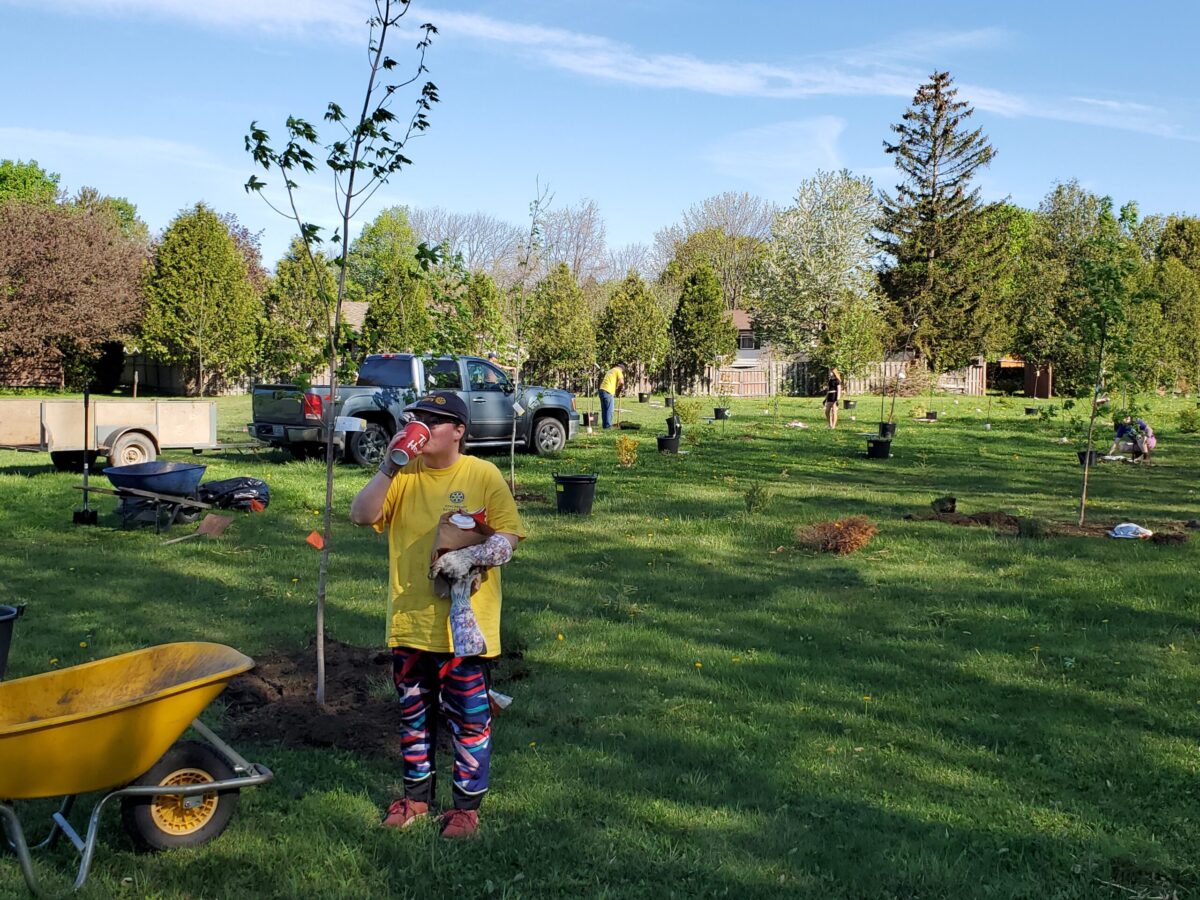
Kincardine Naturalization Projects is working with their local municipality to plant trees in parks that are under utilized.
From starting the Facebook group in 2020 to organizing a tree planting this spring, Doug says they’ve come a long way, but also have a long way to go.
“At first I thought it would just be me and a few other people planting trees, but it’s really caught on. People seem really interested in doing it,” he says.
With a few more parks in their local community that aren’t suitable for soccer, baseball, or other outdoor recreational activities, Doug says they can likely plan for several more tree planting seasons.
This year, they’re working with council and municipal staff to put in a trail through one of the parks they’ve planted trees in so that people can walk through the park and enjoy it.
The Root of the Issue
Doug’s motivation to start Kincardine Naturalization Projects is rooted in how important forests are to the environment.
“Some people might look at a forest like it’s just a bunch of trees. But a forest is a big ecosystem—there are a lot of things living in there. Sometimes there’s a body of water in a forest like a pond or a river. So there are birds, frogs, turtles, and all kinds of wildlife there. Birds drink the water, fly up into the trees, catch insects, and take care of their young. A forest is a totally connected ecosystem. Everything has a purpose and a part,” he explains.
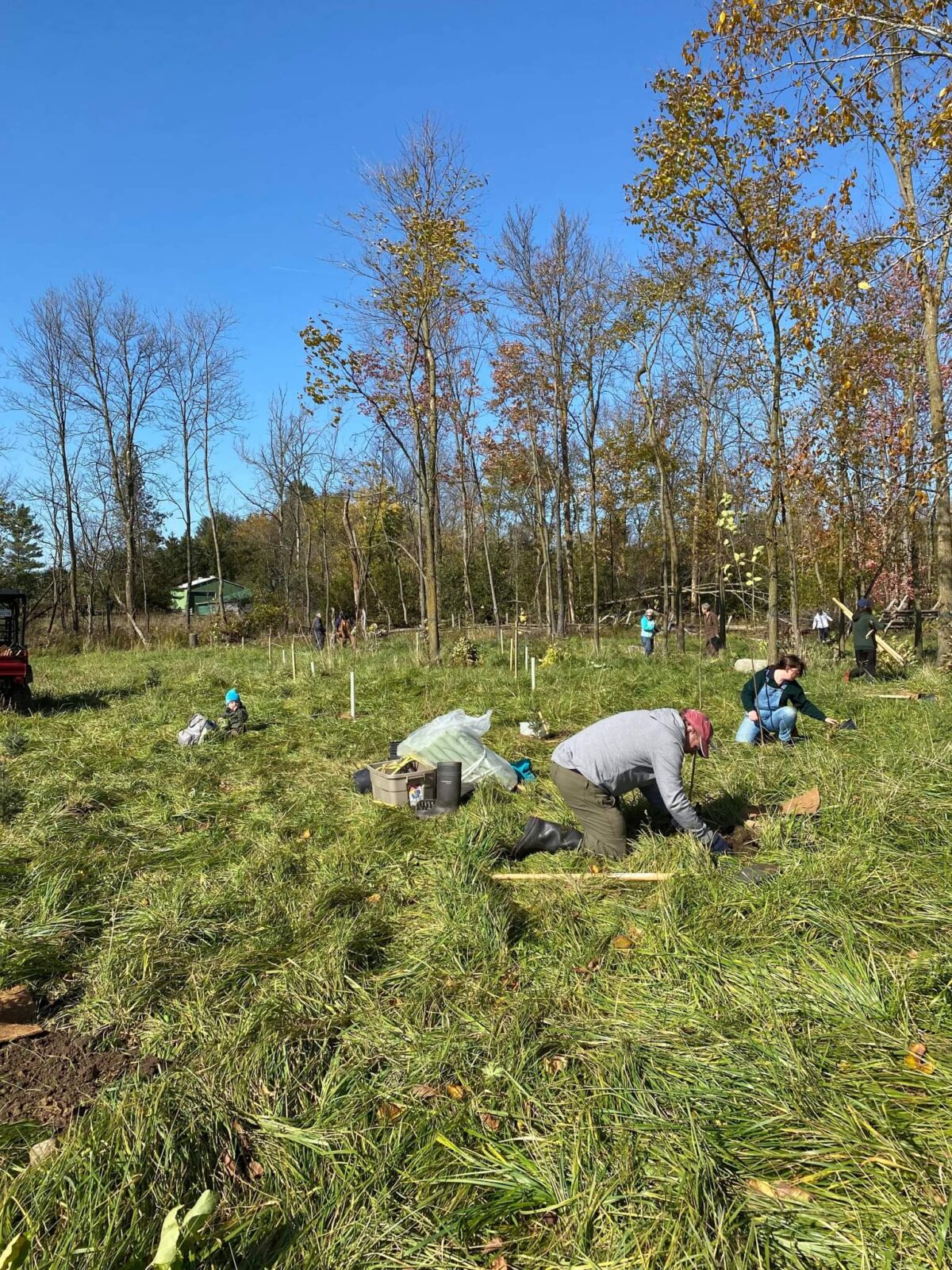
Doug says there’s a lot of interest from the community in helping to increase the number of trees in their community by attending tree planting events. People of all ages come to help in any way they can.
Each forest may also be the only nearby habitat for certain species as well.
“The multitude of species of trees and plants feeds a multitude of species that all rely on it, whether it’s a certain type of tree with a certain type of caterpillar on it that a certain type of bird likes to eat. Once you’ve clear cut a forest, you’ve lost all that. All you have is flat land with nothing on it except soil,” Doug says.
Along with lost biodiversity, clear-cutting disrupts a wide swath of natural processes.
“The other trouble with it is you lose natural drainage. When it rains, the trees draw the water up from the soil. But when there are no trees, what you end up with is a bunch of drainage ditches taking the water away as a storm surge into the rivers, creeks, and lakes causing erosion and a whole lot of other issues,” he says.
When a forest was clear cut near Doug’s home, he noticed the effects of it right away.
“Suddenly, wildlife was wandering everywhere. People were noticing foxes wandering all over the municipality looking sick, wounded, and getting hit by cars. They were starving because there was nothing for them to eat. The mice were gone, all the things they used to eat were gone. They ended up going into town looking for scraps of food to eat,” he explains.
Do What You Can
Doug continues to advocate for a by-law to be put in place, but in the meantime, the group is focused on planting more trees this spring to start providing habitat for other species.
“We want to plant trees that are going to help the other species that live in the area, so we plant trees, plants, and wildflowers that are native to this region. We’re trying to buy locally as much as we can, like from nurseries growing trees that are native to Ontario,” he says.
Their strategy is simple: plant native species and give them the best possible chance to survive and thrive.
“After we tease out the tree’s roots from the root ball, we dig a hole that’s about a third bigger than the size of the pot and we bury it at the same level that it was planted when it was in the pot. We try not to plant after May 10th because we seem to be getting into more drought situations than we used to. When I was growing up, we’d have rain right up until about the end of May, but nowadays we don’t seem to be getting as much rain in the spring,” he says.
After filling in soil around the roots and tamping the ground around the base, Doug says there are a few more things they do to give the growing tree a good chance at survival.
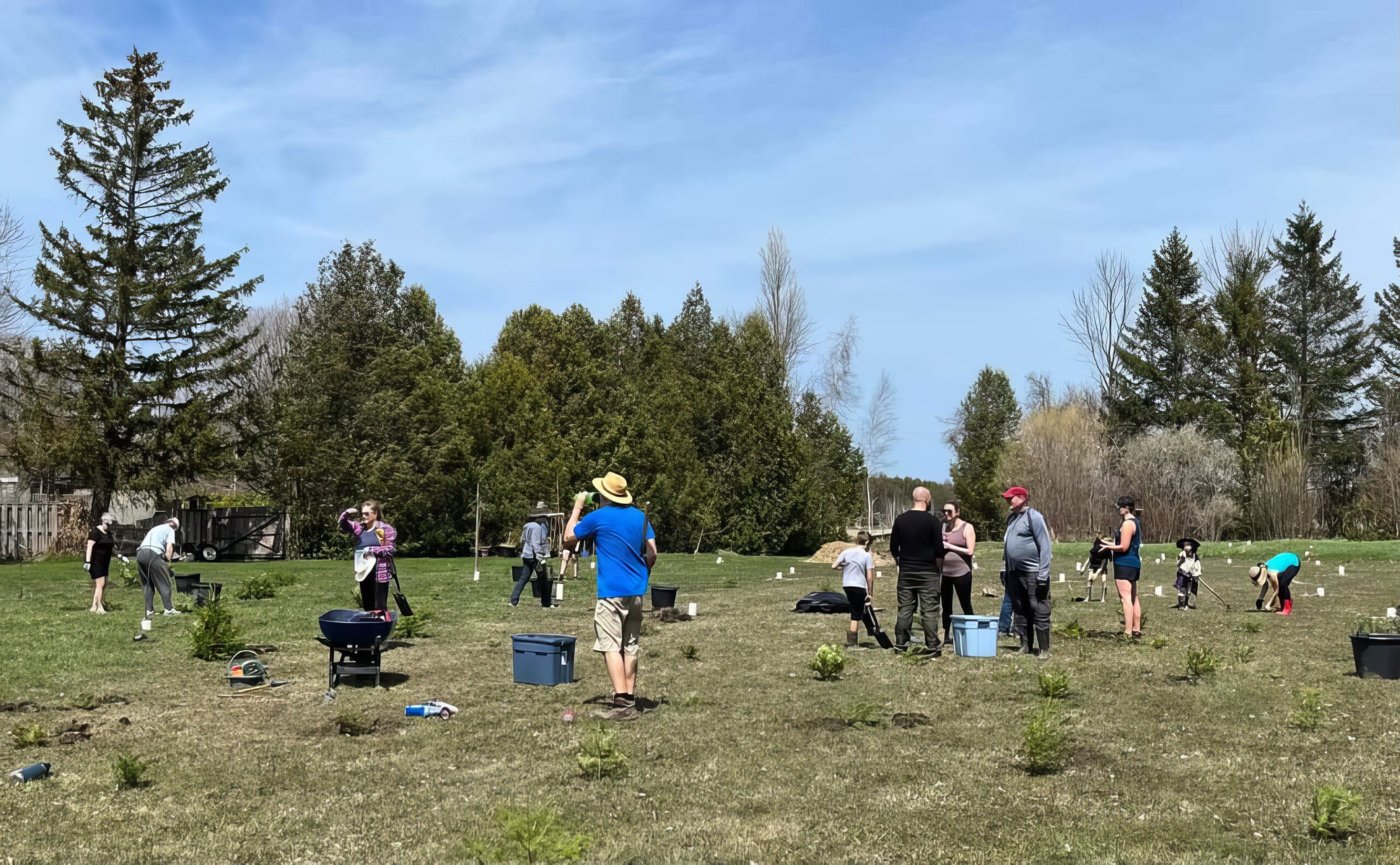
Each step of the tree planting is carefully thought through to give it the best chance of surviving.
“We don’t want to plant a tree and have it die on us, so we put mulch around the base of the tree,” he says.
They’re also planning to use coconut husk mats and pin it down around the tree to help retain moisture and prevent weeds from growing around the base of the tree to prevent competition from other plants growing. They are also hoping to get a large tote of water to the park so they can keep the trees watered in case of a drought.
What You Can Do
If you’re concerned about the trees and forests in your community and want to do something about it, Doug has some advice.
“Find out what the need in your community is. If you’re losing a lot of trees, odds are that there will be a group of people who feel strongly about it and want to do something about it. They may want to create by-laws to stop it from happening. But there will also be people who want to plant trees just because it’s a good thing to do. People who care about the environment know that we have to do something because the climate is changing,” he explains.
Once you’ve found some people who want to spring into action, the next step is to start connecting with your local government.
“The first thing you have to do is find out how much planting you can do in your community. Get in touch with your town council and find out which councillors would be interested in helping you. They can help to encourage other people to get involved too. You need to have some support for what you’re doing,” Doug says.
Whether your group decides to plant trees, wildflowers, or other environmental projects, Doug says it’s important to keep the project manageable.
“As far as the organizing part of it goes, I would start small. We were given just a few small saplings to start with, so start small if that’s all you can get when you start. Then decide what your mandate is and figure out what trees and plants are native to your area. As you become an organization, you need to become a not-for-profit group so you can start applying for grants and funding. There are lots of companies out there like Pattern Canada who want to help, but for a lot of these sponsorships, you need to be a legitimate organization to apply,” he says.
Pattern Energy and Armow Wind are proud sponsors of Kincardine Naturalization Projects.
“Thank you to Armow Wind, who’s providing Kincardine Naturalization Projects with funding for our Savage Park Project. This May, we will be naturalizing five acres. We’ll be planting native trees, bushes, grasses, and wildflowers. Some will have edible fruit, nuts, or berries. We’re hoping this becomes a community space that everyone can enjoy,” the group wrote on their Facebook page.
Visit Kincardine Naturalization Projects on Facebook to see updates about their tree plantings and projects this spring!